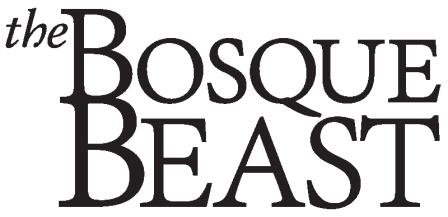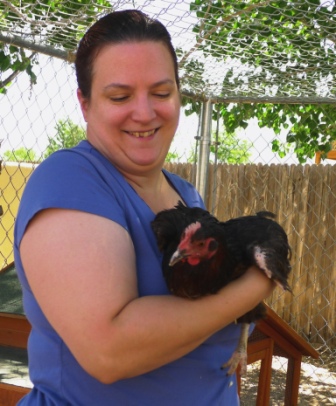
Anatomy of a foster home
Rescuing dogs, cats, and chickens means
a floor plan in flux
When Dawn Janz left Chicago for Corrales in early 2011, she knew she couldn’t leave behind her love of animal rescue — or the half dozen or so foster animals she had ended up adopting herself.
But since most houses are designed for people, plus maybe a dog or two, she had some requirements for a place that could be modified to suit a revolving bunch of four-legged roommates and house guests.
First, no stairs. One of her dogs has paralyzed back legs, and she sometimes takes in animals with mobility issues. That’s why the main rooms have no carpeting either: Her paraplegic dog can more easily drag his legs on tile or wood and not get rug burns.
Next, a bunch of gates were needed to section off the house, plus a dog door to the yard. The house is laid out so dogs and cats can be kept apart, since Janz fosters both. “I have Cat Land and Dog Land, and this is Cat Land,” she says, indicating the large library/office off the hall that contains the bedrooms. She works and sleeps back here with her cats, who don’t make a mess. The carpets are still white, the barking distant, and the furniture fabrics chosen not to trap fur.
A gate in the hallway keeps the dogs up front in the living/dining/ kitchen area, where they have access to the dog door and yard. Of course, a fence had to be installed in the yard to guard against coyotes, but this turned out to be little deterrent in the Corrales sandhills—especially once Janz got some chickens. So the dogs now have a fully enclosed dog run where they can be safe when she’s not around.
And so do the chickens. Janz bit the bullet for a large, fully enclosed coop that she calls the Final Solution. She still managed to lose a chicken, though, when one of her dogs figured out how to grab and pull a bird through the chain link. Dogs are, after all, the coyotes we invite home.
Janz’s house is a continuing work in progress — but she is not one to give up easily. A former project manager for an international bank, she quickly adjusted to her future career prospects by going back to school in nursing.
Likewise, she had planned to continue with Dachshund rescue, but ended up accepting larger dogs plus cats for the Corrales rescue group CARMA. This has meant giving up a front room that was supposed to be for exercise (oh, darn) so the foster cats could be kept someplace where they could be quickly caught.
Janz had her impressive organizational skills tested this summer during the Romero fire, when the whole animal crew had to prep for a possible evacuation. (She wrote about lessons learned in the Aug/Sept issue, “Wildfire! Now where’s Fido?”). The experience of trying to shoehorn everything into her vehicle led to the recent purchase of a used minivan that can haul 10 to 12 small dogs at once, with a lower deck for hauling in cages.
Happily, the blaze stayed well clear of her home. But she was fully prepared to drive back to Chicago, where she still has a house, if no shelters would accept the animals. And she immediately set to work investigating how Corrales would make its own home for animals in case of emergency. “I’ve done rescue a long time,” she says with a shrug. “You learn how to deal with problems.”
Janz hastens to add that any home can be a good place to foster animals as long as the occupants are willing — she fostered dogs for many years in apartments. But “when I chose my house in New Mexico, I wanted to design it to best support the kind of fostering I do, which historically has been the harder-to-place animals.”
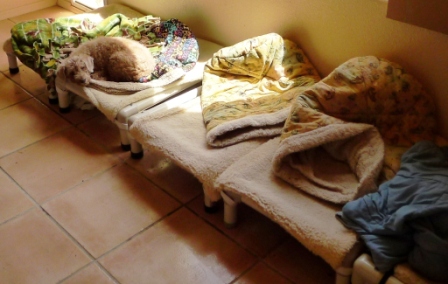
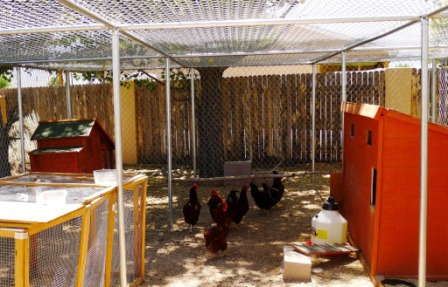
A row of five sleeping platforms keeps the little dogs cozy in their sleeping sacks. Right: "The Final Solution," a state-of-the-art chicken coop protected from canines on all sides
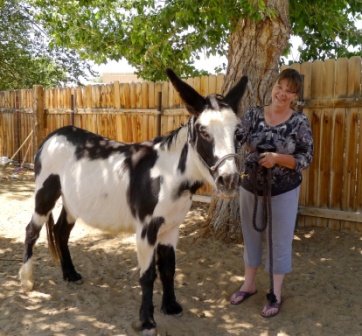
A donkey of a different stripe
Sancho Panza is one of those odd creatures whose striking appearance seems to foretell an adventurous destiny. Rescued from Missouri two and a half years ago, he traveled to Corrales in the company of a zebra bought by Bentley Kassemi, an exotic-animal rescuer who was talked into taking the skinny, skittish creature from a livestock auction. The two striped animals were rumored to be the seeds of a petting zoo, but Kassemi’s plans changed, and Sancho Panza found himself back on the market.
One day in early 2010, Corrales resident Diann O’Neill was driving home on Loma Larga when she found herself doing a 180 at the sight of a zebra-striped donkey for sale. “I thought, Oh my God, he’s meant to be mine,” she said. “I fell in love with him and bought him that day. I think I went straight to the bank to get cash and had him delivered the next morning.”
Sancho Panza spent a year living at her house on Camino Arco Iris, right next door to Mayor Phil Gasteyer. A great watchdog who once alerted O’Neill to her potbellied pig trapped under the gate, the donkey gained fame for his ineffable charisma, apparent to anyone who falls under his scrutinizing, Zen-like gaze.
A restless escape artist, Sancho Panza tore through countless latches and chains, and was known around the neighborhood for his wanderings. He enjoyed hanging with the family pig and German Shepherd, and “he loves kids,” said O’Neill, who attracted loads of attention walking him on the ditchbanks. Even yardworkers would be caught goofing around riding the unflappable beast.
Last month O’Neill, who founded Adobe Computers in 1998, moved to Seattle to be near her grandchildren. She was so heartbroken at having to leave Sancho Panza behind, she couldn’t decide until two days before moving which adoption offer to take. She ended up moving before he did.
The donkey must have understood the situation, she said from Seattle, because he leaped into the trailer of the “really nice man” who ended up taking him home to Los Ranchos. The man is going to buy him some donkey friends, O’Neill reported happily. “He’s the coolest animal I’ve ever known,” she added, growing tearful. “He’ll be happy wherever he goes — he’s like that. But I hope he’ll miss me.”
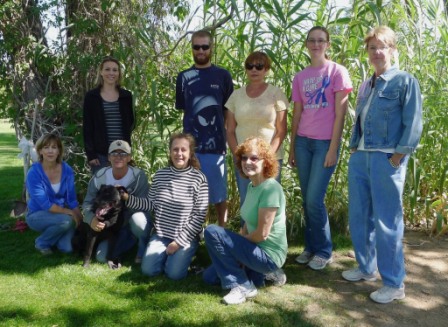
It takes a village
The recently formed Corrales dog walkers had their first organizational meeting on September 15 (see “We do what we can”). Front row, from left: Melinda Helton, Angela Stell, Paula Steinberg, Carolyn Girard; Back: Michelle O’Cleireachain, Ethan Mohan, Gina Hanson, Sarah Coddou, Lesley Small. Not pictured: Daniel Brigman, Rob Girard, Amy Ordogne, Michele Rose.

